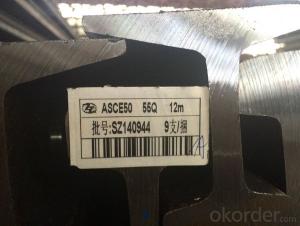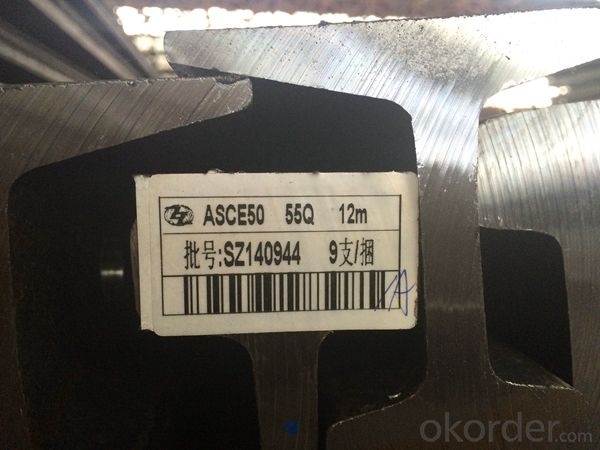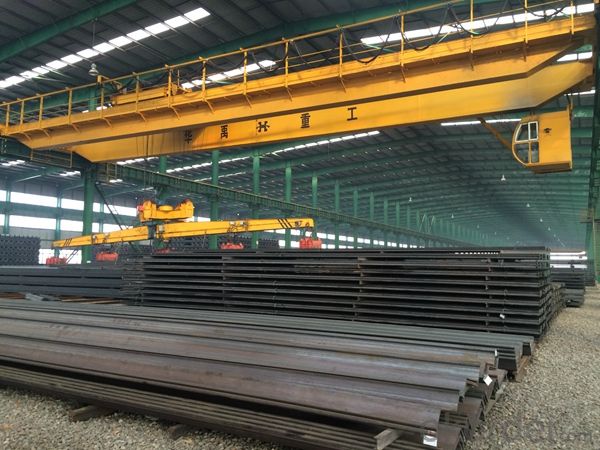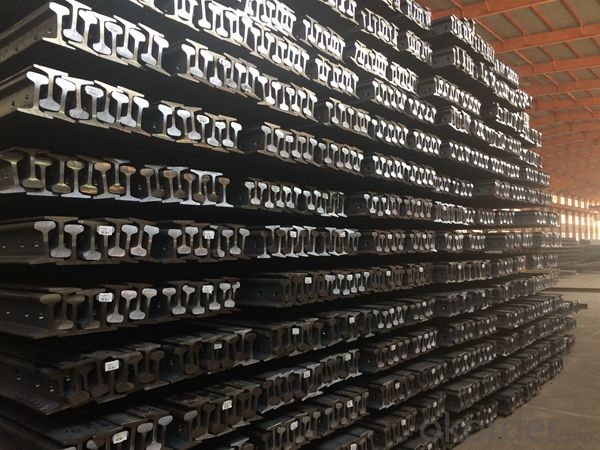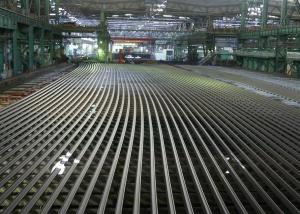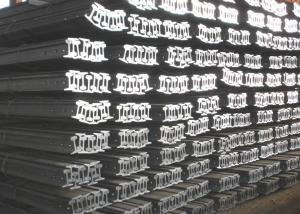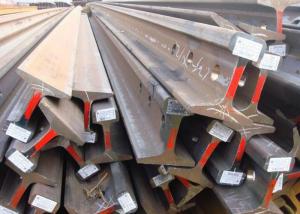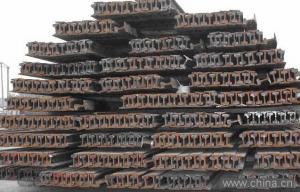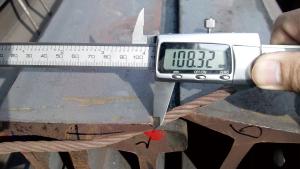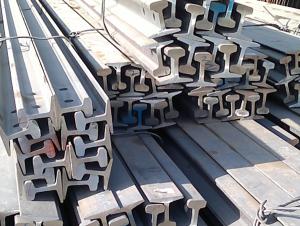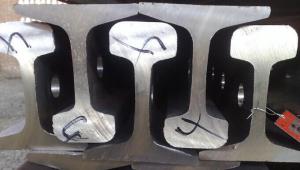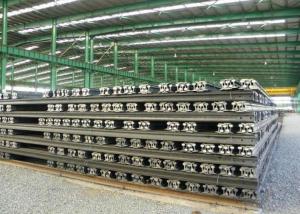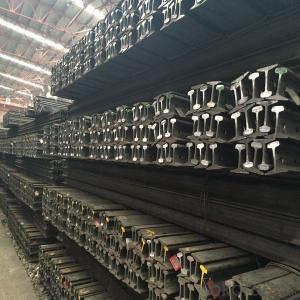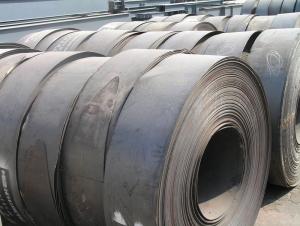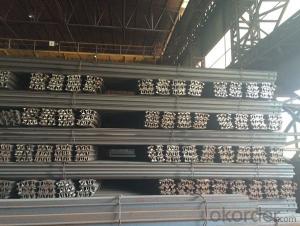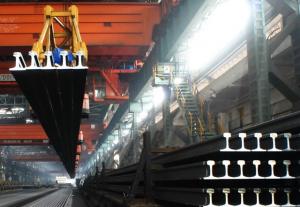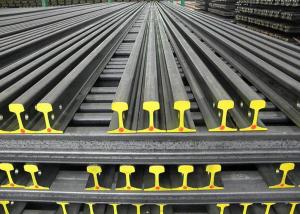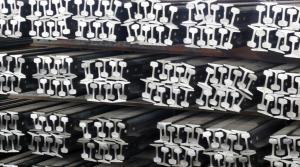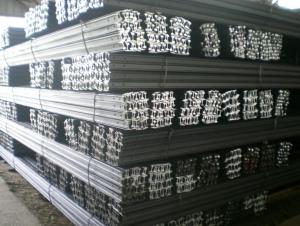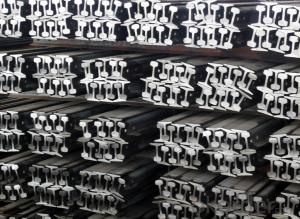Hot Rolled Heavy Steel Rails for Rails of Tren GB38KG, GB43KG
- Loading Port:
- Tianjin
- Payment Terms:
- TT or LC
- Min Order Qty:
- 25 m.t.
- Supply Capability:
- 200000 m.t./month
OKorder Service Pledge
OKorder Financial Service
You Might Also Like
Product Description:
OKorder is offering Hot Rolled Heavy Steel Rails for Rails of Tren GB38KG, GB43KG at great prices with worldwide shipping. Our supplier is a world-class manufacturer of steel, with our products utilized the world over. OKorder annually supplies products to European, North American and Asian markets. We provide quotations within 24 hours of receiving an inquiry and guarantee competitive prices.
Product Applications:
Hot Rolled Heavy Steel Rails for Rails of Tren GB38KG, GB43KG is suitable for the laying of main trunk line of the curves and the orbit of the tunnel, can also be used for tower crane and other crane track. For example: railway, subway, transportation track, express, curve way, tunnel way.
Product Advantages:
OKorder's Hot Rolled Heavy Steel Rails for Rails of Tren GB38KG, GB43KG are durable, strong, and resist corrosion. And they are made of high quality of steel billets.
Main Product Features:
· Premium quality
· Prompt delivery & seaworthy packing (30 days after receiving deposit)
· Corrosion resistance
· Can be recycled and reused
· Mill test certification
· Professional Service
· Competitive pricing
Specificaions of Hot Rolled Heavy Steel Rails for Rails of Tren GB38KG, GB43KG
Production Standard: GB2585-81
Material: 50Mn, U71Mn
Grade | Element(%) | ||||
C
| Mn | S
| P
| Si
| |
50Mn |
0.48—0.56 |
0.70—1.00 |
≤0.035 |
≤0.035
|
0.17-0.37 |
U71Mn | 0.65—0.76 | 1.10—1.40 | ≤0.030 | ≤0.030 | 0.15-0.35 |
Sizes: 38kg, 43kg, 45kg, 50kg, 60kg
Length: 10m, 12m, 12.5m or as the requriement of the clients
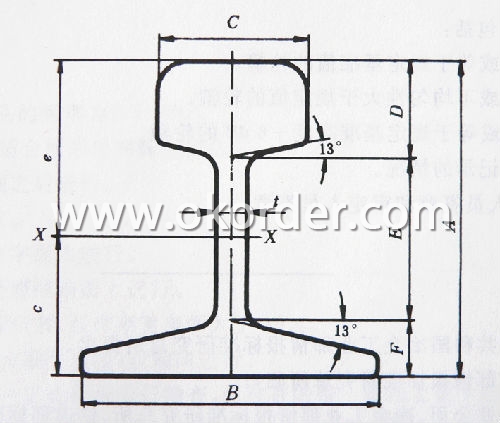

Invoicing on theoretical weight or actual weight as customer request
Payment terms: 30% advance payment by T/T, 70% payment against the copy of the B/L; 100% L/C at sight, etc.
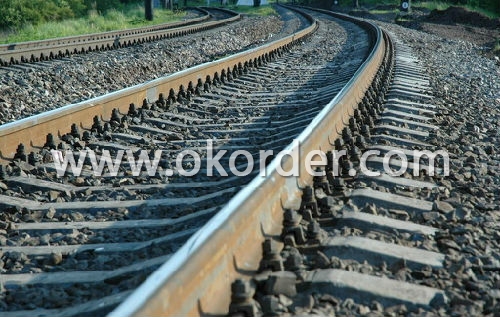
Packaging & Delivery of Hot Rolled Heavy Steel Rails for Rails of Tren GB38KG, GB43KG
1. Packing: it is nude packed in bundles by steel wire rod
2. Bundle weight: not more than 3.5MT for bulk vessel; less than 3 MT for container load
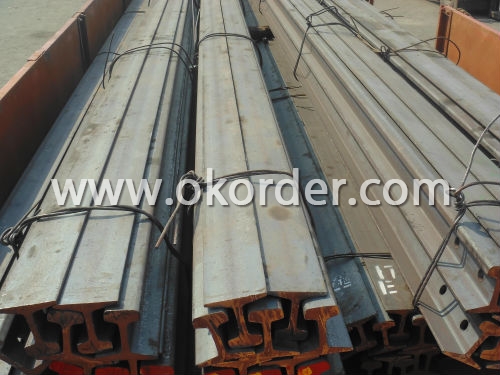
3. Marks:
Color marking: There will be color marking on both end of the bundle for the cargo delivered by bulk vessel. That makes it easily to distinguish at the destination port.
Tag mark: there will be tag mark tied up on the bundles. The information usually including supplier logo and name, product name, made in China, shipping marks and other information request by the customer.
If loading by container the marking is not needed, but we will prepare it as customer request.
4. Transportation: the goods are delivered by truck from mill to loading port, the maximum quantity can be loaded is around 40MTs by each truck. If the order quantity cannot reach the full truck loaded, the transportation cost per ton will be little higher than full load.
5. Delivered by container or bulk vessel
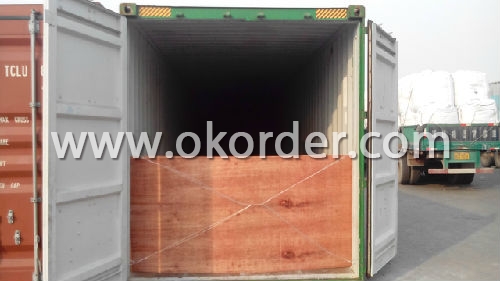
6. Delivery Time: All the Ms Heavy Steel Rail will be transpoted at the port of Tianjin, China within 30 days after receiving the advance payment by T/T or the orginal L/C at sight.
Production flow of Hot Rolled Heavy Steel Rails for Rails of Tren GB38KG, GB43KG
Material prepare (billet) —heat up—rough rolling—precision rolling—cooling—packing—storage and transportation
Inspection of Hot Rolled Heavy Steel Rails for Rails of Tren GB38KG, GB43KG
We will send the MTC of the factory to the clients dirrectly which contain the anlisis of the heat, chemiqul composition, phisical characteristicas, etc.
And our inspectors will arrive at the factory to meke the inspection of the size, length, weight and quantity before the transportation from the factory.
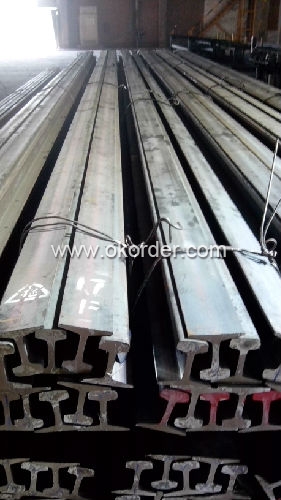
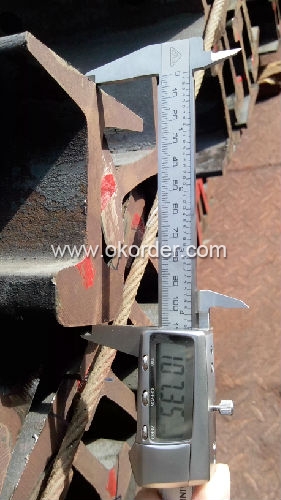
FAQ:
Q1: How do we guarantee the quality of Hot Rolled Heavy Steel Rails for Rails of Tren GB38KG, GB43KG?
A1: We have established an advanced quality management system which conducts strict quality tests at every step, from raw materials to the final product. At the same time, we provide extensive follow-up service assurances as required.
Q2: What is the normal tolerance of Hot Rolled Heavy Steel Rails for Rails of Tren GB38KG, GB43KG?
A2: Normally 3%-5%, but we can also produce the goods according to the customers' requests.
Q3: The products are invoicing on theoritical weight or on actual weight?
A3: We can do it in both manners, according to the customers' request.
- Q: How do steel rails withstand the impact of heavy train wheels?
- Steel rails are specifically designed to withstand the impact of heavy train wheels due to their exceptional strength, durability, and engineering. The combination of these factors allows steel rails to effectively absorb and distribute the immense forces and weight exerted by the train wheels, ensuring the safe and efficient operation of the railway system. Firstly, steel rails are made from high-strength steel alloys that possess a remarkable ability to resist deformation under immense pressure. These alloys are carefully chosen to have a high tensile strength, ensuring that the rails can withstand the weight of the train and the impact forces generated as the wheels roll over them. The high tensile strength of steel rails enables them to maintain their shape and structural integrity, even under the immense load imposed by trains. Additionally, steel rails are engineered with specific dimensions and cross-sectional shapes that enhance their load-bearing capacity. The rails are typically designed with a wide base and a tapered profile, allowing them to distribute the weight and forces applied by the train wheels more evenly. This design helps to prevent excessive stress concentrations, reducing the risk of rail failure or deformation. Furthermore, steel rails undergo a rigorous manufacturing process that includes heat treatment and quality control measures. The heat treatment process involves subjecting the steel rails to high temperatures and controlled cooling, which further enhances their strength, hardness, and resistance to wear. Quality control procedures ensure that the rails meet the required specifications and are free from defects or imperfections. Moreover, steel rails are regularly inspected and maintained to ensure their integrity and safety. Routine inspections involve monitoring the rails for any signs of wear, cracks, or other defects that could compromise their ability to withstand the impact of heavy train wheels. When necessary, damaged sections of rails are promptly replaced to prevent any potential hazards. In conclusion, steel rails are able to withstand the impact of heavy train wheels due to their high tensile strength, specific cross-sectional designs, heat treatment processes, and regular maintenance. These factors collectively enable steel rails to efficiently absorb and distribute the immense forces and weight exerted by the train wheels, providing a safe and reliable infrastructure for railway transportation.
- Q: How are steel rails protected against excessive vibrations?
- Steel rails are protected against excessive vibrations through various methods, such as proper installation techniques, regular maintenance, and the use of specialized resilient materials. These measures help to absorb and dampen vibrations, preventing them from causing damage and ensuring a smoother and safer train ride.
- Q: What is the impact of high temperatures on steel rails?
- Steel rails are greatly affected by high temperatures, resulting in numerous challenges in terms of structure and operation. Firstly, the elevated temperatures cause the steel rails to expand, potentially leading to buckling or warping. This expansion can cause the rails to become misaligned, causing increased wear on both the rails and the train wheels. Furthermore, the expansion of the steel rails due to high temperatures can create gaps between rail sections, known as rail gaps or sun kinks. These gaps introduce instability and can pose safety hazards, potentially resulting in train derailments or accidents. Additionally, high temperatures accelerate the degradation of the steel rails. The heat increases the rate of corrosion and oxidation, causing the rail's surface to deteriorate more rapidly. This deterioration reduces the overall strength and lifespan of the rails, leading to increased maintenance and replacement costs for rail operators. Moreover, it can also impact the reliability and safety of the rail infrastructure. To minimize the impact of high temperatures on steel rails, various measures are implemented. One common approach is the utilization of expansion joints, which allow the rails to expand and contract without causing misalignment or gaps. Moreover, regular inspections and maintenance programs are crucial in promptly identifying and addressing any issues related to thermal expansion and rail degradation. In conclusion, the impact of high temperatures on steel rails is substantial, affecting their structural integrity, safety, and lifespan. It is essential to implement adequate measures and continuously monitor rail transportation systems, particularly in areas with extreme temperature conditions, to ensure their reliability and efficiency.
- Q: How do steel rails handle changes in track maintenance requirements?
- Steel rails are highly durable and can handle changes in track maintenance requirements quite well. They are designed to withstand heavy loads, extreme temperatures, and various weather conditions, making them suitable for both high-speed and heavy-duty railway systems. Additionally, steel rails have low maintenance needs, requiring minimal repairs and replacements over their lifespan. This makes them a cost-effective choice for railway operators, as they can easily adapt to changes in maintenance requirements without compromising on safety or performance.
- Q: Can steel rails be used in railway systems with heavy snowfall?
- Yes, steel rails can be used in railway systems with heavy snowfall. Steel rails are commonly used in railway systems worldwide, including in regions with heavy snowfall. Steel rails are durable, strong, and can withstand the weight of heavy snow loads. Additionally, proper maintenance practices such as snow removal and de-icing are typically implemented in these regions to ensure safe and efficient railway operations.
- Q: What is the expected fatigue strength of steel rails?
- The expected fatigue strength of steel rails varies depending on various factors such as the specific grade and composition of the steel, the manufacturing process, and the condition and maintenance of the rails. However, steel rails typically have high fatigue strength, allowing them to withstand repeated loading and unloading cycles without failure.
- Q: How are steel rails protected against ground movement?
- Steel rails are protected against ground movement through the use of ballast, which is a layer of crushed stones or gravel that is placed beneath and around the rails. The ballast helps to distribute the weight of the train evenly, providing stability and preventing the rails from shifting or sinking into the ground. Additionally, regular maintenance and inspection of the rails are conducted to identify any potential issues and ensure their proper alignment and stability.
- Q: What are the different methods used for rail welding on steel rails?
- There are several methods used for rail welding on steel rails, each with its own advantages and disadvantages. 1. Thermite Welding: This is a commonly used method where a chemical reaction is used to generate intense heat to melt the ends of the rail and a pre-placed thermite mixture. The molten metal then solidifies to form a strong joint. Thermite welding is known for its high strength and durability. 2. Flash Butt Welding: This method involves clamping the two rail ends together and passing a high electric current through them. The heat generated by the resistance of the metal causes the rail ends to become molten, and they are then forged together under pressure. Flash butt welding provides a high-quality joint that is efficient and durable. 3. Gas Pressure Welding: In this method, the rail ends are heated using oxy-fuel flames until they reach a plastic state. Then, the rail ends are pressed together using hydraulic pressure. The heat and pressure create a fusion that results in a strong joint. Gas pressure welding is cost-effective and commonly used for routine maintenance and repairs. 4. Electric Arc Welding: This method involves using an electric arc to melt the rail ends and a consumable electrode, which provides the filler metal. The molten metal solidifies to form a joint. Electric arc welding is a versatile method that can be used for both field and factory welding, but it is less commonly used for rail welding due to its slower process and lower strength compared to other methods. 5. Magnetic Pulse Welding: This is a newer technique where a high-intensity magnetic field is used to accelerate one rail end towards the other. The impact generates heat, and the rail ends are fused together under pressure. Magnetic pulse welding is known for its speed and precision, but it is still being developed for rail welding applications. It is important to note that the choice of welding method depends on various factors, such as the type of rail, location, required strength, and welding equipment availability. Each method has its own advantages and limitations, and the selection should be based on the specific needs and requirements of the rail project.
- Q: How are steel rails affected by seismic activities?
- Steel rails can be affected by seismic activities in several ways. The vibrations caused by earthquakes can lead to the misalignment or displacement of the rails, causing track deformations or even derailments. Seismic activities can also cause damage to the rail infrastructure, such as cracks or fractures in the rails, which compromises their structural integrity and safety. Regular inspections and maintenance are crucial to ensure the resilience of steel rails against seismic events and to promptly address any potential issues.
- Q: What are the safety measures for working on electrified steel rail tracks?
- Working on electrified steel rail tracks can be potentially dangerous, so it is crucial to follow safety measures to ensure the well-being of workers. Here are some important safety measures to consider: 1. Adequate Training: Workers must receive proper training on working with electrified rail tracks. This should include understanding the electrical hazards associated with the tracks, emergency procedures, and how to safely handle tools and equipment. 2. Personal Protective Equipment (PPE): Workers must always wear the appropriate PPE, such as insulated gloves, safety glasses, hard hats, and flame-resistant clothing. Insulated tools should also be used to minimize the risk of electrical shock. 3. Lockout/Tagout (LOTO): Before starting any work, the electrical power supply to the tracks should be properly locked out or tagged out to prevent accidental energization. Only authorized personnel should have access to the lockout/tagout devices. 4. Risk Assessment: Conduct a thorough risk assessment before starting work on electrified rail tracks. Identify potential hazards, such as live wires, faulty electrical equipment, or overhead lines, and implement control measures to mitigate these risks. 5. Communication: Maintain clear communication with other workers, signaling personnel, and train operators. Ensure that all parties are aware of the work being carried out and any potential hazards that may arise. 6. Safe Work Zones: Establish clear boundaries and safe work zones to prevent unauthorized access to the electrified tracks. Use barriers, signage, and warning lights to clearly indicate the presence of electrical hazards. 7. Proper Tools and Equipment: Use only tools and equipment specifically designed for working on electrified rail tracks. Insulated tools and equipment should be regularly inspected and maintained to ensure their integrity. 8. Proper Ladder Usage: When working at heights near electrified tracks, ensure that ladders are made of non-conductive materials and are positioned away from live wires or overhead lines. Workers should avoid leaning or touching any electrical components while on the ladder. 9. Emergency Preparedness: Have a well-defined emergency response plan in place in case of accidents or incidents. Train workers on emergency procedures, including evacuation routes, first aid, and how to respond to electrical shock or burns. 10. Regular Inspections and Maintenance: Regularly inspect the electrified rail tracks, electrical equipment, and tools to identify potential issues or defects. Any faulty equipment or infrastructure should be immediately reported and repaired to prevent accidents. It is crucial to prioritize safety when working on electrified steel rail tracks. By following these safety measures, workers can minimize the risks associated with electrical hazards and ensure a safe working environment.
Send your message to us
Hot Rolled Heavy Steel Rails for Rails of Tren GB38KG, GB43KG
- Loading Port:
- Tianjin
- Payment Terms:
- TT or LC
- Min Order Qty:
- 25 m.t.
- Supply Capability:
- 200000 m.t./month
OKorder Service Pledge
OKorder Financial Service
Similar products
Hot products
Hot Searches
Related keywords
